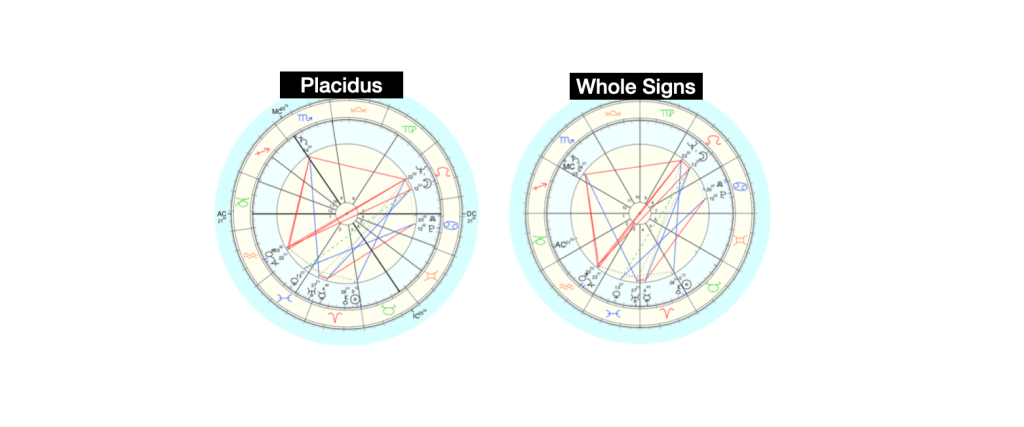Houses are one of the most important – but also most controversial – topics in astrology.
The 12 signs are pretty straightforward – they are 30° each. Houses, less so.
There is no one single house system; there are several. They all ‘work’ in their own different ways, by highlighting a different ‘flavor’ of the chart.
Some house systems seem to work better with certain techniques (e.g., transits). Others better fit particular interpretation styles. It’s really all about understanding what each system’s value proposition is – and then using it with awareness.
HOUSE SYSTEMS: Placidus And Whole Sign Houses
Out of the tens of existing house systems, Placidus and Whole Sign Houses are the most popular. The most popular – AND the most different.
If we find similarities between some house systems (e.g., Placidus and Porphyry, or Whole Sign and Equal Houses) – Placidus and Whole Sign Houses are completely different.
Perhaps it’s their methodological difference that makes them the most debated house systems in contemporary astrology.
More than any other topic in astrology, there are some diehard Whole Sign advocates, as well as loyal Placidus users. There’s either ‘Team Placidus’ or ‘Team Whole Sign Houses.’
How can two – so different – house systems both ‘work’? There must be one that’s the correct one, right?
Here at the Astro Butterfly School, we believe that there’s no one ‘correct’ house system. Both house systems work – BUT in their own unique ways.
This means that the type of astrological insight you can derive by using one house system can be different than what emerges from using the other.
To understand what makes them different – but also suited to different applications – let’s talk a bit about the theory behind each:
Astrology was born well before houses, which are a more recent development. For a long time, astrology was observational – noting the day might involve tracking eclipses or the heliacal rising of planets. Then the 12 signs were conceptualized.
Houses – and natal charts – were a later addition, likely emerging from the need to apply astrology not only to kings and nations, but to regular individuals.
The fact that we have the same number of signs and houses speaks to an intrinsic conceptual link between the two. The houses – conceptually – originate from the signs. That’s why we have 12 houses – and not 24, 35, or any other random number.
The first obvious house system to be used was Whole Sign Houses – where the same principle used to derive the 12 signs was applied to the natal chart, resulting in 12 houses.
With Whole Sign Houses, the same theoretical framework that created the zodiac signs is applied to houses. In this system, each sign encompasses one entire house. For example, if your Ascendant is in Gemini, your first house is entirely Gemini, the second house is entirely Cancer, and so on.
What matters from a Whole Sign House perspective is which sign your house is in – the sign itself becomes the house.
Later, new house systems were developed. Equal Houses are similar to Whole Signs (they are 30° each), but they start with the degree of the Ascendant. So if your Ascendant is 5° Gemini, your 2nd house begins at 5° Cancer, and so on.
The difference here is that the Ascendant is no longer synonymous with the 1st house cusp; if a planet is above the horizon in your chart – even if in the same sign (for example at 2° Gemini) – with Equal Houses it moves into the 12th house.
Later, the Midheaven (MC) and the IC were included in house calculation. This is how the so-called “Quadrant” house systems – like Placidus – came about. Since the MC and IC are not necessarily 90° from the Ascendant-Descendant axis (unless you’re located right on the equator), Quadrant house systems – unlike Whole Sign or Equal – generate unequal houses.
There are many Quadrant house systems in use (they differ in how they divide the space between the angles), but the most popular one is Placidus.
Placidus is the most widely used house system, largely because most astrology software use it as the default. If you got your chart online or from an astrologer and you’re unsure which house system it’s based on – chances are, it’s Placidus.
The particularity of Placidus – and other Quadrant house systems – is that the Midheaven becomes an important anchor in the chart. And what is the Midheaven? Fundamentally, an expression of the Earth’s tilt and our geographic latitude.
Different latitudes – and times of year – can skew the Midheaven more to the right or left, giving us unequal houses. We could say that with Placidus, location matters.
Placidus Vs. Whole Sign Houses
Whole Sign Houses reflect the inbuilt design of the solar system, as mapped onto your natal chart.
Placidus is all about location, location, location.
And this difference is what helps determine which system works best for what.
Whole sign houses are a reflection of the 12 basic archetypes. Hence the premise that a house can only contain 1 sign – not 2, or 3 (or 12, if you’re at the Pole, where the horizon disappears).
So with Whole Sign Houses, with a Gemini rising, your 2nd house is Cancer, period. Not a bit of Gemini, a bit of Cancer. Not a bit of Cancer, a bit of Leo. This approach creates coherence in chart interpretation.
With Placidus, the sky’s the limit – quite literally, if we consider the method used to calculate it (with the Midheaven representing the highest point in the sky from the observer’s perspective). This suggests that Placidus is more terrestrial – more grounded in Earth, time, and the observer’s physical location on the globe.
With Whole Signs, the 12 houses – based on the 12 signs – are rooted in the solar system’s cycles, so we could say Whole Signs has a more ‘fated,’ Sun-centric expression.
Placidus, in contrast, is more about the Earth and the individual’s unique circumstances. It’s about the concrete expressions of celestial influences here on Earth.
Many people identify more with Placidus because it feels more personal, more specific to time and place – like a tailored imprint of the sky the moment you were born.
Placidus tends to be more ‘obvious’ because it shows up in ways that are more relatable from a terrestrial perspective – yet it might not explain the ‘DNA’ of the natal chart and underlying influences in the same way Whole Signs does.
Placidus AND Whole Sign Houses
Do both Whole Signs and Placidus work? Absolutely. It’s really about understanding the difference between the two – what sets them apart, and in which circumstances we might choose one over the other.
In interpretation, Whole Signs works well for big-picture themes, consistent life areas, and transits. Placidus is rich in nuance and tends to show how we actually experience the houses – how the ‘DNA’ of the Whole Sign house manifests in the terrestrial realm.
As we can see, different house systems can emphasize certain aspects of your chart differently. Some systems may align better with your interpretive style, while others might work better with specific techniques.
Some astrologers use only one house system – and it works great for them. Most likely, their interpretation style is also tailored to the unique features of that particular system.
Others primarily use one house system (for example, Placidus), but turn to Whole Sign Houses for particular techniques – such as Annual Profections.
And then there are those who use both systems in the same reading – usually people with plenty of experience working with each one individually – and manage to get the best of both worlds.
Placidus And Whole Sign Houses – How Do They Work?
If you’re interested in the topic of house systems – particularly the differences between Placidus and Whole Sign Houses – Caro from Astro Butterfly School will run the “Placidus and Whole Sign House Systems: How Do They Work?” webinar on this topic on April 25th, at noon EST.
In this webinar, she’ll explore the conceptual differences between Placidus and Whole Sign Houses and how they function differently in practice. Expect lots of chart examples!
The webinar if for you if:
You are at least somewhat familiar with Placidus and Whole Sign houses – even if you don’t actively use both – and you’re curious to explore how they compare.
You’re want to learn how to work with both Placidus and Whole Signs
You want to understand the theory and meaning of different house systems in depth
The webinar might not suit you if:
You’re not familiar with natal charts and houses (hint: if you’re not sure what your 3rd house cusp is, then this webinar will likely be too advanced)
You feel very strongly about one of these two house systems and are looking to prove the other ‘wrong’
You’re working with a different house system (e.g. Equal, Porphyry etc) and aren’t particularly interested in exploring Placidus or Whole Sign Houses
If you’re interested, you can purchase a ticket at THIS LINK.
The ticket includes access to:
The live event on April 25th (you’ll receive email reminders with the Zoom link prior to the call)
The webinar recording, transcript, and slides – including chart examples
An additional video explaining the conceptual differences between the most commonly used house systems: Whole Sign Houses, Placidus, Equal Houses, and Porphyry
A cheat sheet with side-by-side comparisons
Practice exercises and reflection prompts to help you apply these insights to your own natal chart
The materials will become available by April 26th, 2025 (you will receive an email once they’re ready).
[WEBINAR] Placidus and Whole Sign House Systems: How Do They Work?
The post Placidus And Whole Sign Houses – How Do They Work? first appeared on Astro Butterfly.


